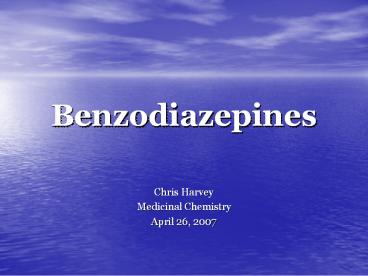Benzodiazepines - PowerPoint PPT Presentation
Title:
Benzodiazepines
Description:
The first benzodiazepine (benzo) was synthesized by an Austrian scientist named ... SSRIs (Prozac, Zoloft, Lexapro, etc.) Atypical anxiolytic/antidepressant drugs ... – PowerPoint PPT presentation
Number of Views:5067
Avg rating:3.0/5.0
Title: Benzodiazepines
1
Benzodiazepines
- Chris Harvey
- Medicinal Chemistry
- April 26, 2007
2
Overview
- History
- Clinical Applications
- Mechanism of Action
- Structure
- General
- Sub-classes
- Individual examples
- Future Research
3
History
- The first benzodiazepine (benzo) was
synthesized by an Austrian scientist named Dr.
Leo Sternbach in the mid 1950s while working at
Hoffman-La Roche. The new compounds potential
as a pharmaceutical was not initially recognized,
however, Dr. Sternbachs persistent research
eventually uncovered its efficacy as a
tranquilizer. In 1959, chlordiazepoxide
(Librium) was introduced as the first of many
benzos to come. Just four years later, in 1963,
diazepam (Valium) came on the market. Clinicians
quickly recognized the potential of benzos as a
safer alternative to the barbiturate class of
anxiolytics.
4
Clinical Applications
- Anxiolytic
- GAD, PTSD, OCD, etc.
- Panic Disorder
- Specific Phobias
- Anticonvulsant
- Status epilepticus
- Myoclonic epilepsy
- Muscle relaxant
- Sleep aid
- Pre-operative anesthesia
- Alcohol withdrawal
5
Mechanism of Action
- Benzodiazepines act as GABA (?-aminobutyric
acid) potentiators. They bind to BZ receptors on
the GABA-BZ receptor complex, which allows them
to allosterically modulate and enhance the
activity of GABA. This results in increased
hyperpolarization at target neurons, making them
less responsive to excitatory stimuli.
6
Structure
- 2-Keto Benzos
- Some administered as prodrug
- All have active metabolites (commonly
desmethyldiazepam) - Long half-lives (most in excess of 60 hours)
- 3-hydroxy Benzos
- No active metabolites
- Not metabolized in the liver
- Intermediate half-lives (most 8-20 hours)
- Triazolo Benzos
- Additional heterocyclic ring attached at the 1
and 2 positions - Some active metabolites
- Short to intermediate half-lives (anywhere from
3-14 hours)
Diazepam
1
2
3
7
2-Keto Benzos
Chlordiazepoxide (Librium)
Diazepam (Valium)
- First isolated benzo
- Oxidized to desmethyldiazepam in the liver
- Indicated for treatment of anxiety and insomnia
- Most prolific and versatile benzo
- Indicated for treatment of anxiety, seizure,
muslce tension, insomnia, and alcohol withdrawal
8
2-Keto Benzos
Flurazepam (Dalmane)
Clonazepam (Klonopin)
- High potentcy ( 20 times stronger per miliigram
than diazepam) - Causes moderate anterograde amnesia
- Indicated for treatment of anxiety, also a highly
effective anticonvulsant
- Longest half-life of any benzo ( 40-250 hours)
- Indicated primarily for treatment of insomnia,
may also serve as an anxiolytic
9
2-Keto Benzos
- The original date-rape drug, and the origin of
the term roofie - Pharmacologically very similar to clonazepam, but
possesses much stronger amnesic properties. - One of only two drugs in the U.S. for which a
first possession charge is a mandatory felony.
The other of the two is crack cocaine.
Flunitrazepam (Rohypnol)
10
3-hydroxy Benzos
Lorazepam (Ativan)
Oxazepam (Serax)
- Indicated for treatment of anxiety, seizure,
insomnia, panic disorder, and alcohol withdrawal. - Unique among benzos in its use as an adjunctive
anti-emetic
- Indicated for treatment of anxiety, insomnia, and
alcohol withdrawal. - Common metabolite of many 2-keto benzos following
their oxidation to desmethyldiazepam
11
Triazolo Benzos
Alprazolam (Xanax)
Triazolam (Halcion)
- First benzo approved by FDA for treatment of
panic disorder. - Also used as an adjunctive treatment for
depression while adjusting to SSRIs.
- Very rapid onset
- Very short half-life
- Possesses amnesic properties similar to
clonazepam - Used almost exclusively as a pre-op anesthetic
12
Future Research
- Research is moving away from benzodiazepines as
they are being displaced by newer drugs, which
generally have fewer side-effects and lower
addiction potentials. - Newer anxiolytics
- SSRIs (Prozac, Zoloft, Lexapro, etc.)
- Atypical anxiolytic/antidepressant drugs
- Buspirone (BuSpar)
- Venlafaxine (Effexor)
- Duloxetine (Cymbalta)
- Newer sleeping medications
- Zolpidem (Ambien)
- Zaleplon (Sonata)
- Eszopiclone (Lunesta)
13
References
- Schatzberg M.D., A. F., Cole M.D., J. O.,
DeBattista M.D., C. (2005) Manual of Clinical
Psychopharmacology. 5th edition. Washington DC
American Psychiatric Publishing Inc. - Schatzberg M.D., A. F., Nemeroff M.D., C. B.
(2006) Essentials of Clinical Psychopharmacology.
2nd edition. Washington DC American
Psychiatric Publishing Inc. - Katzung M.D., B. G. (2001) Basic and Clinical
Pharmacology. 8th edition. McGraw-Hill. - www.wikipedia.com

